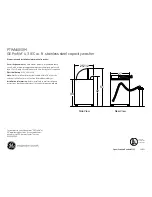
EN
12
Wash cycles
Wash cycle
Wash cycle
which
include
drying
Options
Approximate
duration of wash
cycles
Water
consumption
(l/cycle)
Energy
consumption
(KWh/cycle)
Normal
*
Yes
Delayed start – Tabs –
Extra Dry
03:10’
9,7
0,672
Auto 65°
Yes
Delayed start – Tabs – Extra
Dry – Short Time – Zone wash
02:00’ - 03:10’
14,0 - 15,5
1,50 - 1,80
Auto 55°
Yes
Delayed start – Tabs – Extra
Dry – Short Time – Zone wash
01:30’ - 02:30’
14,5 – 16,0
1,20 - 1,35
Auto 50°
No
Delayed start – Tabs
00:40’ - 01:20’
13,0 - 14,5
1,15- 1,25
Duo Wash
Yes
Delayed start – Tabs –
Extra Dry – Short Time
02:00’
18,0
1,30
Delicate
Yes
Delayed start – Tabs –
Extra Dry
01:40’
11,0
1,10
Express 30’
No
Delayed start – Tabs
00:30’
9,0
0,50
Soak
No
Delayed start
00:12’
4,5
0,01
Instructions on wash-cycle selection and detergent dosage
1.
The NORMAL wash cycle is the standard cycle to which the energy label data refers. It can be used to wash crockery with a
normal soil level and is the most efficient cycle in terms of energy and water consumption for this type of crockery.
Open the door at end of programme by 50mm to assist in drying. Add detergent amounts for cycle: 29 gr/ml + 6 gr/ml** – 1 Tab
(**Quantity of pre-washing detergent)
2.
Heavily soiled dishes and pans (not to be used for delicate items). 35 gr/ml – 1 Tab
3.
Normally soiled pans and dishes. 29 gr/ml + 6 gr/ml** – 1 Tab
4.
Limited quantity of daily soiling (ideal for 4 place settings) 25 gr/ml – 1 Tab
5.
Wash spread over the two racks: delicate for crystal and glasses on the upper rack and heavy duty for the pans on the lower
rack.
35 gr/ml – 1 Tab
6.
Cycle for delicate items, which are more sensitive to high temperatures 35 gr/ml – 1 Tab
7.
Fast cycle to be used for slightly dirty dishes (ideal for 2 place settings) 25 gr/ml – 1 Tab
8.
Pre-wash while awaiting completion of the load with the dishes from the next meal. No detergent.
Standby consumption: Left-on mode consumption: 5 W - Off mode consumption: 0.5 W.
Notes:
Optimum performance levels when using the “Fast" and "Express 30’” cycles can be achieved by respecting the specified
number of place settings.
To reduce consumption even further, only run the dishwasher when it is full.
*
The Normal wash cycle adheres to the regulation standard
AS/NZS 2007
. Although it has a longer duration than other wash cycles
it uses less energy and is less harmful to the environment.
Note for Test Laboratories:
for information on comparative EN testing conditions, please send an email to the following address:
The number and type of wash cycles and options may vary depending on the dishwasher model.


































